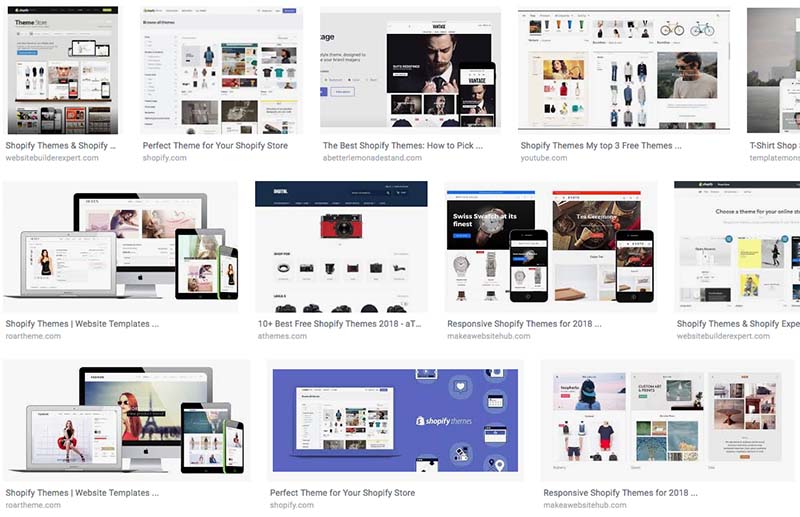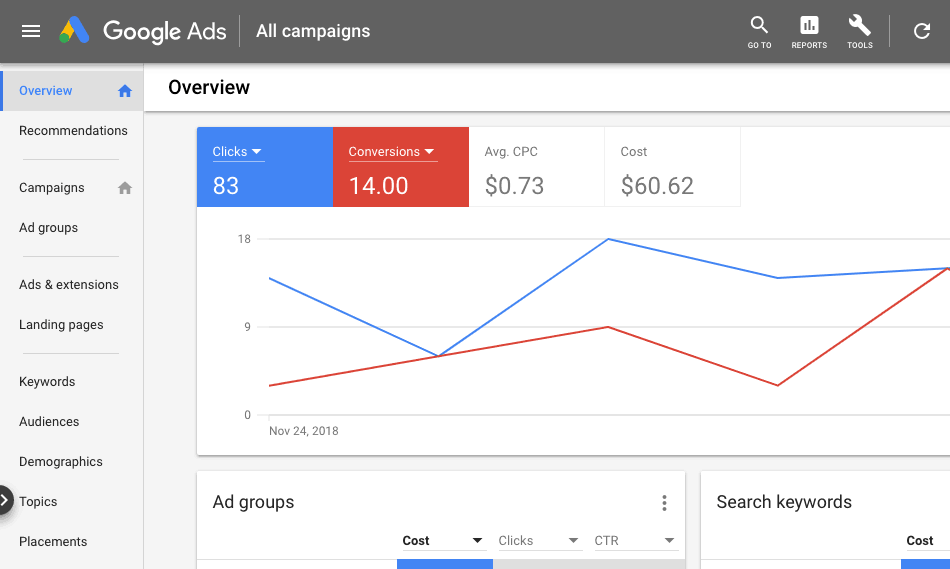So you've conquered eBay with inkFrog. Maybe even Amazon. And now it's time to take the next logical e-commerce step and open your own Shopify store.
As it turns out, selling on Shopify is very different from selling on eBay or Amazon, in a variety of ways, as you'll soon discover. Here are eight big-picture tips that can help you to navigate these differences.

Pre-built design work for Shopify and for websites abounds online. Spend a little and get a head start, rather than trying to do everything yourself. (Image: Google)
They won't tell you everything that you need to know to succeed on Shopify, but they do tell you where to look to address some of the problems and uncertainties that you'll need to resolve on your way to the top.
Map Shopify listings to eBay listings as you create them. Don't get off on the wrong foot by leaving yourself with inventory confusion. Go over or double-check your synchronization settings after linking your Shopify store to inkFrog, then map your Shopify listings to existing eBay listings.
Spend time on your store getting it right. Shopify is different from eBay and Amazon in that you are responsible for most of the shopper experience, not just individual product listings. Spend time building your store and doing it well. Build out your home page and category pages carefully.
Include high-quality branding and image materials. Spend time building and talking about your brand. Clearly show who your company is and what it aspires to be. Include high-quality photography or images that go beyond the products that you sell and instead illustrate your business, brand, and identity.
Invest in work done by others. Unless you're already a pro at design, don't spend time reinventing the wheel when you don't have to. Use good third-party themes and good stock images and icons to get up and running rapidly. Spend your time customizing already successful design assets for your own brand, not creating them from scratch.

Make content about your products. Lots of content. Even better if it’s video content. It’s how to get shoppers in the front door at Shopify. (Image: © Diego Cervo / Fotolia)
Optimize and advertise. eBay and Amazon have a built-in audience of millions. Not so with your Shopify store. Learn the ins and outs of SEO and content marketing and use them. Then, look into paid advertising via Google or social media. On eBay, you've been a mall store. On Shopify, you're in your own building in the suburbs.
Start blogging or vlogging. Create a blog on your site and ideally open a vlog (a space for your own videos) as well. Start producing content. Lots of content. SEO and advertising will prime the pump, but over the long term, it's the social content that you produce that will be make-or-break for your Shopify business.
Make clear customer service policies and adhere to them. Front-and-center feedback scores and ratings on eBay and Amazon—along with platform-wide policies—have previously structured your customer service life. Now you're on your own. Spend time and dollars to get customer service right, to ensure growth in the long run.
Understand that your store is never done. The eBay and Amazon home page experiences are constantly changing because shoppers respond to and buy what's just arrived, is on sale, or is seasonally interesting. Now you're in charge of a home page experience, and the rest of the experience as well. Keep your store constantly evolving in new, interesting, and sales-friendly ways.

If you want shoppers at your Shopify store, especially early on, you're probably going to have to advertise. (Image: Google)
Keep it simple. With near-total control, just about every task on your Shopify store can become an open-ended one. This bogs some sellers down. Don't try to become everything you've ever dreamed of at once. You'll never get there. Build what you need, build it well, and move on. You can try to achieve "perfect" later on, once you have "profitable" in place.
Go beyond eBay and Amazon but keep your store in sync with them, too. Your eBay or Amazon stores are assets you've spent months or years building, so ensure that there are overlap and synergies between them and your Shopify store. No need to make them exact duplicates, but make clear that they're the same brand, using what you've learned on eBay and Amazon to help you.
It's Like a Whole New Business
On eBay or Amazon you've always been most concerned with the nuts and bolts of selling—sourcing inventory, getting it online, representing it accurately, pricing it competitively, and fulfilling as orders roll in. Marketing played second fiddle to day-to-day operations.
On Shopify, you're jumping in at the deep end of e-commerce, where you'll need to become a marketing guru as well. It's going to feel like a whole new business—but the increase in creative and branding flexibility can also mean a whole new world of sales.
Play your cards right, keep the points above in mind, and you'll be on your way to success.
Join the Newsletter
Get started for free today!
Try it free
Join the 200,000+
using inkFrog!




